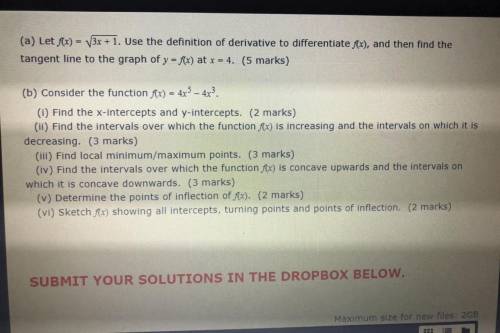
Mathematics, 06.12.2021 04:00 wolfia6aj
(a) Let f(x) = √√3x + 1. Use the definition of derivative to differentiate f(x), and then find the tangent line to the graph of y = f(x) at x = 4. (5 marks)
(b) Consider the function f(x) = 4x5 - 4x³.
(i) Find the x-intercepts and y-intercepts. (2 marks)
(ii) Find the intervals over which the function f(x) is increasing and the intervals on which it is
decreasing. (3 marks)
(iii) Find local minimum/maximum points. (3 marks)
(iv) Find the intervals over which the function f(x) is concave upwards and the intervals on which it is concave downwards. (3 marks)
(v) Determine the points of inflection of f(x). (2 marks)
(vi) Sketch f(x) showing all intercepts, turning points and points of inflection. (2 marks)


Answers: 2


Another question on Mathematics

Mathematics, 21.06.2019 19:00
What will the graph look like for a system of equations that has no solution? a. the lines will be perpendicular. b. the lines will cross at one point. c. both equations will form the same line. d. the lines will be parallel.
Answers: 1

Mathematics, 21.06.2019 20:30
2/3(-6y+9x) expand each expression using the distributive property
Answers: 3

Mathematics, 22.06.2019 02:00
Jared had 3/7 of the minutes on a family phone plan remaining for the month. the plan is shared by 2 people. if divided equally what portion of the minutes remaining on the phone plan would be avalible for each person
Answers: 1

Mathematics, 22.06.2019 02:30
Atrain traveled for 1.5 hours to the first station, stopped for 30 minutes, then traveled for 4 hours to the final station where it stopped for 1 hour. the total distance traveled is a function of time. which graph most accurately represents this scenario? a graph is shown with the x-axis labeled time (in hours) and the y-axis labeled total distance (in miles). the line begins at the origin and moves upward for 1.5 hours. the line then continues upward at a slow rate until 2 hours. from 2 to 6 hours, the line continues quickly upward. from 6 to 7 hours, it moves downward until it touches the x-axis a graph is shown with the axis labeled time (in hours) and the y axis labeled total distance (in miles). a line is shown beginning at the origin. the line moves upward until 1.5 hours, then is a horizontal line until 2 hours. the line moves quickly upward again until 6 hours, and then is horizontal until 7 hours a graph is shown with the axis labeled time (in hours) and the y-axis labeled total distance (in miles). the line begins at the y-axis where y equals 125. it is horizontal until 1.5 hours, then moves downward until 2 hours where it touches the x-axis. the line moves upward until 6 hours and then moves downward until 7 hours where it touches the x-axis a graph is shown with the axis labeled time (in hours) and the y-axis labeled total distance (in miles). the line begins at y equals 125 and is horizontal for 1.5 hours. the line moves downward until 2 hours, then back up until 5.5 hours. the line is horizontal from 5.5 to 7 hours
Answers: 1
You know the right answer?
(a) Let f(x) = √√3x + 1. Use the definition of derivative to differentiate f(x), and then find the t...
Questions


History, 21.03.2020 05:35

Advanced Placement (AP), 21.03.2020 05:35

Mathematics, 21.03.2020 05:35

History, 21.03.2020 05:35



Health, 21.03.2020 05:36

Mathematics, 21.03.2020 05:36

Mathematics, 21.03.2020 05:36



Mathematics, 21.03.2020 05:36


History, 21.03.2020 05:36

Physics, 21.03.2020 05:36

Mathematics, 21.03.2020 05:36





